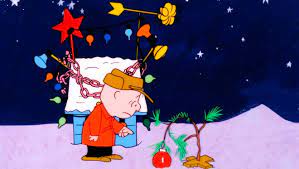Writing Lessons & Advice: Basics of Plot
- Katie Johns
- Dec 4, 2023
- 4 min read
Updated: Jul 19, 2025

I feel a need to apologize...my pantsing ways have caught up with me.
I recently realized that, in my previous lesson about plot and story elements, the basics of plot were never touched on! I’m sure I had every intention to do so but got carried away in the other elements. So I’m sorry I didn’t give plot as much attention before. I’m actually studying it now in preparation for a novel I might write in the coming year, so let’s have a look together:
Again, a general definition of plot is the summation of what happens in a story. Plot is the action and events that move a story forward. A story isn’t a story without one.
Basic elements of a plot include exposition, inciting incident/conflict, rising action, climax, falling, action, and resolution. For illustrative purposes, I’ll identify these elements as they appear in my favorite television Christmas special, Charlie Brown Christmas. Spoiler warning in effect! Lol

Exposition- the information that serves as your background or foundational information to a story. The prominent people or places of the narrative are typically introduced here.
The exposition of Charlie Brown Christmas is the opening scene with the Peanuts gang skating on the ice pond. All of the gang are seen again throughout the story. The setting is further established by the scene’s soundtrack: a song titled “Christmastime is Here”. To further emphasize the prominent characters, the beginning sequence is interspersed with Charlie Brown and Linus discussing his feelings about the time of year.

inciting incident/conflict and rising action- Once the prominent people and places are established, an inciting incident or conflict disrupts their lives in some way. Challenges, mysteries, obstacles, or roadblocks get in their way. Rising action, then, is their dealing with said challenges, mysteries, obstacles, or roadblocks. These parts may entail a large part of a story.
Charlie feels like he doesn’t understand Christmas, which is the major obstacle he tries to overcome throughout the story. He visits with the others around town, hoping to find answers. Though little avails at first as Snoopy is busy decorating his house for a lights & display contest, his friends are playing in the snow, and his sister is seeking help writing a letter to Santa.
Charlie manages to get time with “psychiatrist” Lucy who thinks that directing the Christmas play will give him what he's looking for. This starts our rising action and brings with it its own challenges as the rest of the gang is reluctant to cooperate with him and each other. At the peak of frustration, Charlie Brown and Lucy agree to an idea of having a Christmas tree on set to help set the mood for rehearsals. Charlie and Linus return with a dinky tree and good intentions, but the rest of the gang laugh and ridicule him.
Climax- the turning point of the conflict, involving some kind of victory or defeat.
In Charlie’s moment of defeat and humiliation, he lamentingly wonders if anyone knows what Christmas is all about. In response, Linus quotes the Christmas story from the gospel of Luke.
Falling action- Falling action is like the home stretch of your story. It may involve the aftermath of the aforementioned conflict resolution, like returning to normal or establishing a new normal. Any loose ends could be addressed.
Everyone’s spirit changes after Linus quotes the Bible story. Charlie Brown feels inspired to decorate the dinky tree and show the gang that it is worthy of the play. One “loose end” addressed here is finding that Snoopy’s doghouse won first prize in the contest. Charlie Brown tries to add an ornament from the house to the dinky tree but it's unable to take the weight.
Resolution- Sometimes called denouement, this is the point of the story’s conclusion. All those loose ends should tie up the big picture and present some kind of satisfying ending, if not a hint to a follow-up.
After Charlie sulks off, thinking he killed the tree, the gang arrives and changes their mind about it. “Maybe it just needs a little love,” Linus declared, giving the tree the support it needed to handle a full makeover. Charlie Brown hurries back, wondering what’s going on, and he’s astounded at what they’d done! They all shout, “Merry Christmas, Charlie Brown!” and close the story by singing, “Hark the Herald Angels Sing”.
Every story needs a plot to be interesting and every plot needs these key ingredients. As discussed in the original lesson, the characters, events, and experiences within can give a plot its own flavor, but every story from Peanuts to Grinch to Krampus all have some sort of exposition, conflict, action, and conclusion. Identifying them in your own reading--or holiday binging-- can help you become more proficient in developing plot points in your own creative writing!
I hope this was a better look at the basics of plotlines and I hope your holidays go well!
What are your favorite holiday specials/films/stories? You may find that you mention elements of the plot in discussing them! Leave a comment about your favorites or anything else you’d like me to cover in the future!
Sources/Further reading:
















Comments